#Colletes inaequalis
Text
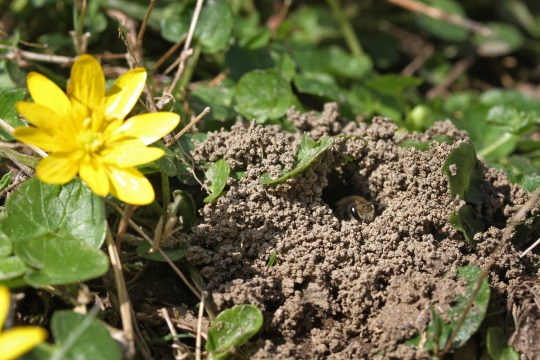
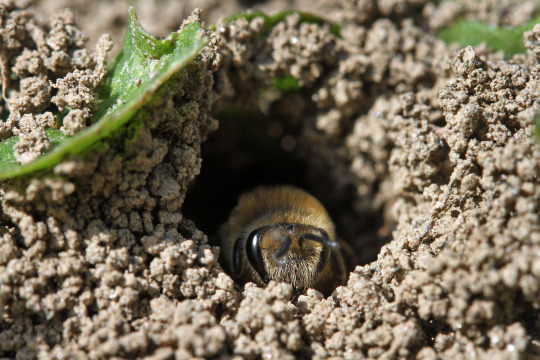
Ground-nesting bee time! (Well, all the warm months are, but I see them mostly first thing in the spring before everything grows in.)
Unequal Cellophane Bee female in her nest (Colletes inaequalis)
March 13, 2024
Southeastern Pennsylvania
#bee#bees#photographers on tumblr#bugs#bug#bugblr#unequal cellophane bee#Colletes inaequalis#entomology#insects#insect#nature#beeblr#animals#wildlife photography
1K notes
·
View notes
Text

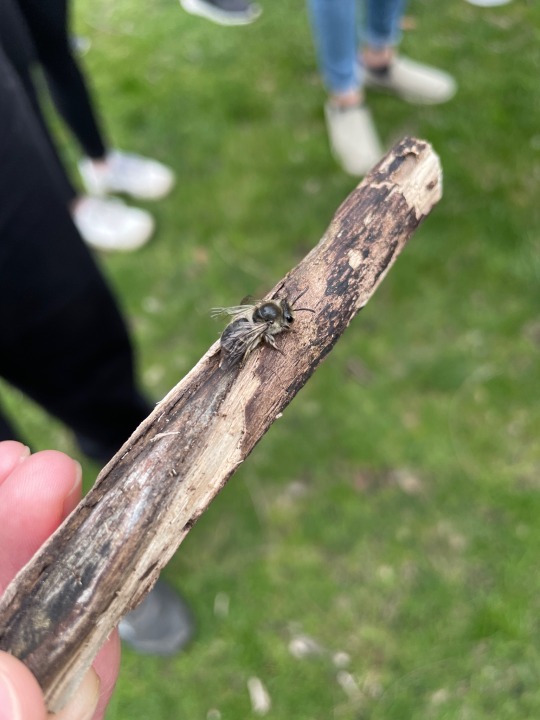

The ground nesting bees have decided the weather is good enough to make an appearance. If you see these lil gals, please let them be(e)! They’re very unlikely to sting (I’ve bothered them so much, no stings) and are great for native plants! iNaturalist suggests to me these particular bees are the unequal cellophane bee, Colletes inaequalis.
#photo#entomology#bees#cute#cute animals#insect photography#insect#bee#arthropod#invert#their little faces when they poke out of nest 😭#bugblr
25 notes
·
View notes
Photo

Unequal Cellophane Bee (Colletes inaequalis)
1 note
·
View note
Photo


I made some friends while working at the beach habitat restoration. <3
Colletes inaequalis, the cellophane bee, is a native North American species of solitary bee that digs deep burrows in sandy soil (or just sand, as they were here). They line the inside of the burrow with a naturally-secreted polyester, hence their common name.
They’re stupendously docile and sweet little things, so as scary as seeing a bunch of them buzzing low over the ground might be, don’t be afraid! They’re just looking for a new spot to burrow. If you have them in your yard, protect their burrow areas by reducing foot traffic and holding off on weeding or tilling for a while. They’re excellent pollinators.
#bee#native bees#colletes inaequalis#cellophane bee#insects#bugs#wildlife#nature#have I mentioned that I f***ing love bees because seriously#bees are the best#chicago#clark street beach bird sanctuary#my photography
2 notes
·
View notes
Photo
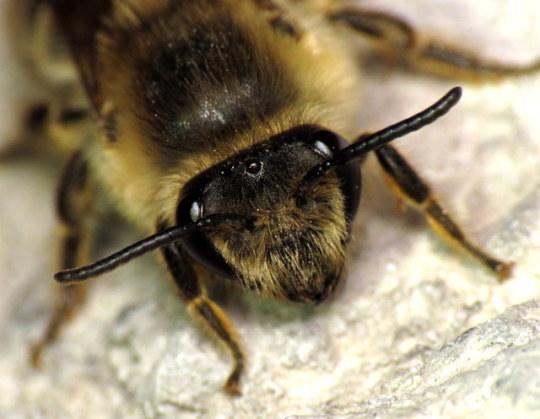
Bug of the Day
Look at the fuzzy face on this little Unequal Cellophane Bee (Colletes inaequalis) I found at my porch light the other night. So sweet!
Thanks to John S. Ascher for the id.
Update: @inverte-brat asked about the origin of the name “unequal” cellophane bee. I did some googling and was not able to figure it out. I did find out that they are called cellophane bees because of a clear, plastic-like substance they produce that they use to coat the walls of their underground nests, in order to keep them dry.
#unequal cellophane bee#Colletes inaequalis#Colletes#Colletidae#Hymenoptera#insect#bee#cellophane bee
224 notes
·
View notes
Text
@abstracttheworld submitted: This is that ground bee I was talking about before! :D I live in virginia btw.
What a cute bee! I don’t remember the context or if you had a question so I will just say it’s a very adorable bee friend :)
And also if you had asked for an ID, it looks like a cellophane bee, proooobably Colletes inaequalis.
66 notes
·
View notes
Photo




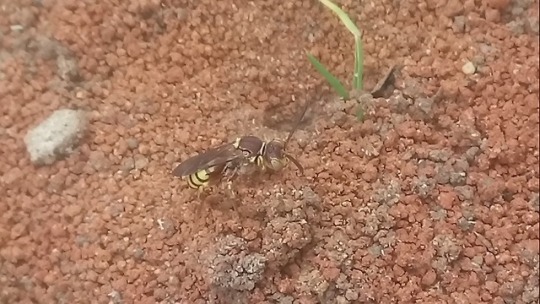
Bee watch for today! Hung out at the colletes nest for a while in carytown, richmond Top: collete Middle: halictid (lasioglossum probably) Bottom: nomada If anyone can identify these further down let me know!! I think the colletes is inaequalis but I'm not confident in that ID hah
18 notes
·
View notes
Text
Yesterday I saw a bunch of bees coming to dig a bit in the freshly tilled soil in the plant beds. I thought they might be going for the water or minerals in the dirt, so I put out a little bowl with rocks in it (for landing), but they were uninterested. They stuck to the dirt.
Internet tells me they were likely drinking water for the minerals there. And they are possibly polyester bees (solitary plasterer ground bees that coat their nests with a type of polyester secretion [Colletes inaequalis]). Super cute and not really bothersome, even when I was digging nearby to plant the onions and Ripley the cat pounced on them.
the internet tells me they are native and unlikely to cause allergic reactions if stung, due to that status. Also, they are major pollinators of apple trees, shrubs, and berries.
In another note: I saw a bumblebee yesterday too! I’ve been waiting to see bees in my backyard all week, and now they’ve finally arrived - though they don’t seem interested in the dandelions, only in the dirt.
0 notes
Text


First native bee of the year! And pollen covered as a bonus. I'm very happy.
Unequal Cellophane Bee (Colletes inaequalis)
February 27, 2024
Southeastern Pennsylvania
#bugs#bug#photographers on tumblr#bugblr#bee#bees#unequal cellophane bee#Colletes inaequalis#entomology#insects#insect#nature#wildlife photography#animals
609 notes
·
View notes
Text

What do you think she's announcing from her little lilac podium?
Unequal Cellophane Bee (Colletes inaequalis)
April 9, 2024
Southeastern Pennsylvania
#bee#bees#photographers on tumblr#unequal cellophane bee#bugs#bugblr#bug#Berber#entomology#insects#insect#nature#Colletes inaequalis#animals#wildlife photography
371 notes
·
View notes
Text

Went bee hunting today and was not disappointed.
Unequal Cellophane Bees (Colletes inaequalis)
March 12, 2024
Southeastern Pennsylvania
#bee#bees#photographers on tumblr#unequal cellophane bee#cellophane bees#Colletes inaequalis#bugs#bug#bugblr#entomology#insects#insect#nature#animals#wildlife photography#beeblr
267 notes
·
View notes
Text

Unequal Cellophane Bee (Colletes inaequalis)
March 15, 2024
Southeastern Pennsylvania
#On a sunny day in spring you will often find me lying in the dirt next to bee nests#bee#bees#photographers on tumblr#unequal cellophane bee#colletes inaequalis#bugs#bug#bugblr#entomology#insects#insect#nature#animals#wildlife photography
163 notes
·
View notes
Photo


My favorite sign of impending Spring, the first ground-nesting bee nest of the year!
Unequal Cellophane Bee, female (Colletes inaequalis)
March 5, 2023
Southeastern Pennsylvania
#bee#bees#photographers on tumblr#Colletes inaequalis#unequal cellophane bee#beeblr#bug#bugs#insect#insects#bugblr#It's so good to be shooting with a working camera! Thank you!!#entomology#nature#animals
373 notes
·
View notes
Text



Is it weird that my Spring happy place is lying on a sunny south-facing slope surrounded by dozens of bee nests?
Unequal Cellophane Bees (Colletes inaequalis)
Females emerging from their nests, and males (in center photo) waiting for a female to emerge from her nest.
Early Spring 2023
Southeastern Pennsylvania
#bee#bees#photographers on tumblr#beeblr#unequal cellophane bee#Colletes inaequalis#hymenoptera#bug#bugs#bugblr#insect#insects#entomology
179 notes
·
View notes
Photo

A male bee, to pair with the female in her personal nest that I posted earlier in the week.
Unequal Cellophane Bee (Colletes inaequalis)
March 6, 2023
Southeastern Pennsylvania
Temps are going to be below average for the next week, so may be a while before I see these guys again.
#bee#bees#photographers on tumblr#Colletes inaequalis#unequal cellophane bee#beeblr#animals#nature#flowering apricot#flowers#spring#entomology
113 notes
·
View notes
Text


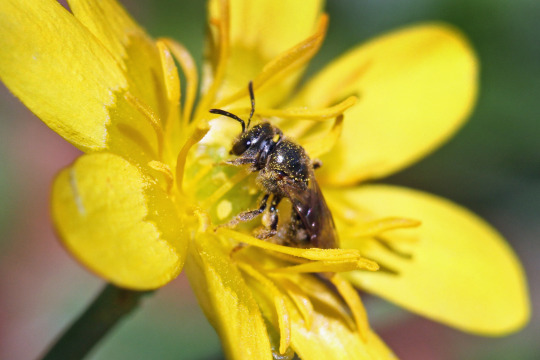
Native bees on Lesser Celandine (Ficaria verna)
Unequal Cellophane Bee (Colletes inaequalis)
Carlin's Mining Bee (Andrena carlini)
Metallic Sweat Bee (Lasioglossum sp.)
March 26, 2023
Southeastern Pennsylvania
99 notes
·
View notes